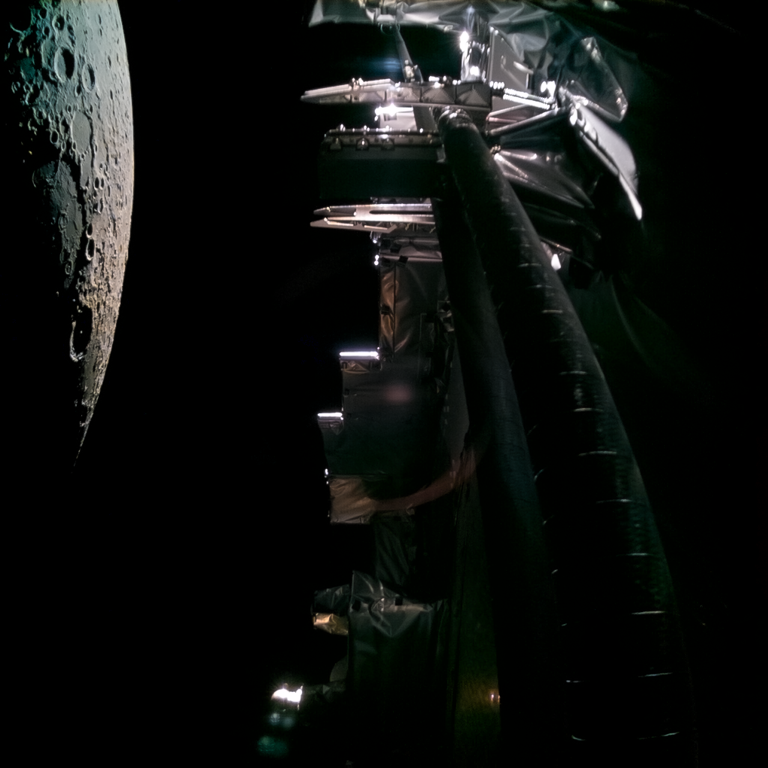A spacecraft zoomed by the moon on August 19, 2024, in a thrilling flyby that captured breathtaking, sci-fi-like footage. The European Space Agency’s (ESA) Juice mission, also known as the Jupiter Icy Moons Explorer, made history as it soared between Earth and the moon, snapping surreal views of the lunar surface. The mission is part of an ambitious plan to explore the distant, icy worlds of the solar system.
As the spacecraft passed close to the moon, ESA’s monitoring cameras recorded stunning images of the cratered surface. The visuals were a perfect blend of 21st-century technology and space exploration, offering a sci-fi-like perspective of the moon that had people in awe. ESA director Josef Aschbacher shared the excitement online, stating, “Sometimes the journey is just as worthy as the destination.” He was referring to the Juice mission’s flyby, which marked the first-ever lunar-Earth flyby for the spacecraft. This historic event provided an exceptional glimpse of Earth’s natural satellite.
Black Myth: Wukong Takes World by Storm, Forcing Gamers to Learn About Chinese Culture
These images are just getting better and better 😍 Raw images from #ESAJuice are being sent down to Earth as we speak, we'll publish the processed versions as soon as we can.
— ESA's Juice mission (@ESA_JUICE) August 19, 2024
In the meantime, enjoy our live broadcast of the very first images that came down 👇 https://t.co/pVtpc0e5kl pic.twitter.com/y4VHSOgDAr
The spacecraft’s flyby was a carefully planned maneuver. The Juice mission took advantage of Earth’s and the moon’s gravity to slingshot itself further into space. The plan is for the spacecraft to continue speeding toward the deep solar system, making additional flybys of Venus and Earth twice more to gain the momentum needed for its journey. Juice’s ultimate destination is Jupiter, where it is expected to arrive in 2031. Once there, it will swoop by 35 of Jupiter’s moons, focusing on some of the most mysterious and intriguing celestial bodies in the solar system.
One of the unique aspects of the Juice mission is its ability to capture high-quality images of the spacecraft’s surroundings. The footage taken during the lunar flyby showcases the spacecraft itself, with its antennae and instruments visible in the foreground, set against the backdrop of the moon’s surface. The combination of modern space technology and the majestic lunar landscape gives the images a sci-fi feel that is both thrilling and humbling.

After the successful flyby, Juice is now on course to fly by Earth once again, scheduled for August 20. This maneuver is another step in the spacecraft’s journey toward Jupiter, where it will begin its mission to explore the planet’s icy moons. The spacecraft is designed to withstand the extreme conditions it will encounter near Jupiter, including intense radiation. Similar to NASA’s Juno spacecraft, Juice is protected by specialized shielding. However, Juice is even larger than Juno, with two massive cross-shaped solar panels that make it the largest solar-powered spacecraft in the solar system.
Rakesh Bhatt | Indian-American Priest’s Vedic Prayer Steals Spotlight at DNC Day 3 – Watch Now!
These solar panels are a crucial part of the mission. Because Jupiter is so far from the sun—an average of 484 million miles—the solar radiation it receives is 25 times weaker than what we experience on Earth. To ensure the spacecraft has enough power to carry out its mission, the solar panels stretch an impressive 71 feet (21.7 meters) wide, making Juice a veritable “solar power plant” in space, as ESA describes it.

Juice’s mission is to explore some of Jupiter’s largest and most fascinating moons, including Europa, Ganymede, and Callisto. These moons are more than just cold, distant objects. They are considered “possible habitats” by ESA, with Europa in particular suspected of harboring a vast ocean beneath its thick ice shell. This raises exciting possibilities for the existence of life, making the Juice mission one of the most anticipated space exploration missions in recent years.
Harris Unveils Bold Economic Plans for 2024 – Will Populist Proposals Win Over Voters?
The spacecraft’s long journey will involve in-depth studies of these icy moons, with the goal of uncovering more about their potential to support life. Europa’s hidden ocean has captured the imaginations of scientists for years, and Juice’s mission could bring us closer to understanding what lies beneath its icy surface. Ganymede and Callisto are also of great interest, with Ganymede being the largest moon in the solar system and potentially containing a subsurface ocean.
The Juice mission is a prime example of how modern space exploration continues to push the boundaries of what is possible. By capturing stunning, sci-fi-like footage of the moon and beyond, Juice offers a glimpse into the future of space exploration. The mission’s journey to Jupiter and its moons is not just about the final destination, but also about the incredible sights and discoveries along the way.


